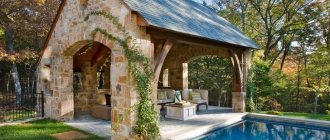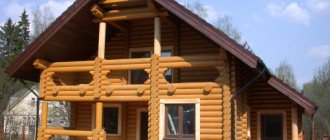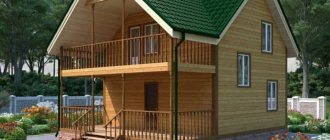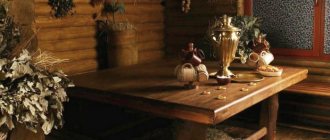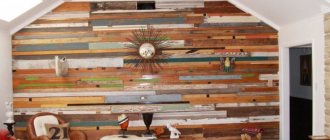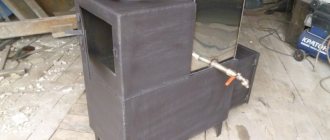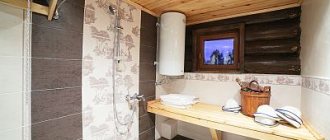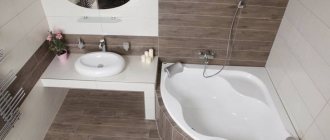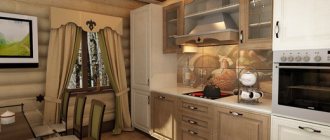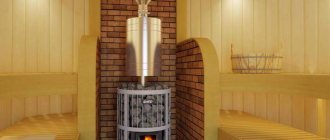Home » Building a house » Construction and repair
PremisesConstruction and renovation
Alexander Korovaev 03/24/2020
50470 Views
SavingsSavedRemoved 8
A country plot with a house is considered finally equipped when the architectural design of a bathhouse with a terrace, a relaxation room and a barbecue area is completed. The bathhouse was an element of Slavic life. It served to cleanse the body, hence the ancient name “soap box”.
The Slavic peoples had a bath cult. They loved to steam.
The process of going to the bathhouse itself is a kind of ritual, including: knitting brooms, preparing herbal decoctions, natural mixtures for cleansing the body with birch tar, honey. Many religious rituals are associated with the bathhouse.
The design of a bathhouse with an attached spacious terrace and gazebo is the most common type of structure. Despite the fact that the role of the soap bar was replaced by a bath or shower stall, they could not displace the bathhouse. For a modern person, this is a place for wellness treatments, leisure, an opportunity to relax, and have a great time in the company of friends.
The desire to implement a bathhouse project on the site is subconsciously built into our hereditary code. The owner may not brag about the house, but he will emphasize “what a bathhouse I have.”
A suitable project is selected from catalogs on the Internet. It is possible to combine a bathhouse with a summer kitchen and billiard room.
Photos of bathhouse projects with a terrace
Even at the planning stage, it is important to correctly determine the location of the future structure so that the developed technical documentation complies with the norms of current legislation.
When designing, it is necessary to take as a basis SNiP 30-02-97 and SP 11-106-97, which clearly define the rules for the development of suburban areas and indicate the recommended distance of the structure being created from other objects.
According to the standards, the minimum permissible distance of a bathhouse from other buildings, vegetation to:
- main residential building - from 7 to 10 m;
- roadway - from 6 to 7 m;
- borders of the estate, fence - from 1 to 3 m;
- neighbors’ houses – from 15 to 17 m;
- wooden utility blocks - from 10 to 13 m;
- structures made of non-combustible materials - from 6 to 9 m;
- well – 10 m;
- forests – 16 m;
- trees – 4 m;
- bushes - 2 m.
If the terrain allows, then the craftsmen recommend building a bathhouse on a hill to simplify the drainage of water from the steam room, shower and improve ventilation. In this case, screw piles will be the best foundation.
Let's take a closer look at the features and advantages of different designs with a terrace with examples of finished objects in the photo.
Construction of a building
Building a bathhouse is not a long process. Therefore, this structure can be installed first and live there while the construction of the main residential building is underway. In addition, everything necessary for living can be provided at once: a small kitchen, sleeping places and a bathroom.
Project of a bathhouse made of logs 6x9 m
The terrace is usually made open, limiting the perimeter with only a small fence. However, you can completely isolate it by installing, for example, glazing. An interesting solution when constructing a terrace is a sliding glass wall, which allows you to combine the living room with the terrace.
A barbecue on the terrace will allow you to concentrate all the necessary elements of a comfortable stay in one place.
A sauna with a gazebo and barbecue (grill table, barbecue) would be an excellent solution
Stages of work
Step 1. Site preparation.
4a380a731dc2641f319e367cfb12e345.jpe d2a22589c35dbde640b7b8fd9f8e35e8.jpe
f1048bca563cf5dc039c60bdec0f6964.jpe
Step 2. Construction of a foundation (its type is determined by the type of soil, load, time allotted for the work and financial capabilities), which can be monolithic, columnar, strip or pile.
Step 3. Construction of a bathhouse frame with a terrace.
The process of building a bathhouse with a terrace
Step 4. Installation of the roof structure.
Step 5. Cladding the building and insulating it.
Step 6. Installation of the floor.
Step 7. Installation of the stove and chimney (it is not needed for the electric model).
Step 8. Interior decoration.
Step 9. Conducting communications.
Bathhouse project with attic and terrace
The most important question that needs to be resolved when starting work is what to build a bathhouse from, as well as a terrace for it. In addition, the purpose of the building imposes some additional requirements for both construction and finishing.
Materials from which a bathhouse and terrace can be made
The extension must fit harmoniously into the overall architectural ensemble. Often it is made from the same building material as the bathhouse itself. Or from a design that matches it. The choice may be influenced by: the dimensions of the future building, the place intended for its installation, the material aspect.
The material must provide a good microclimate in the premises. It requires high resistance to temperature changes and high humidity levels. The environmental aspect must also be taken into account. No harmful substances should be released into the atmosphere under the influence of steam.
A wooden bath has many advantages over a brick, block or sandwich panel
Most often, baths are built from wood. These can be logs or timber; frame structures are also popular, in which wood is combined with other types of materials
But when using wood, it is necessary to pay attention to its treatment from the effects of climatic factors, and also, using special impregnations, to increase the resistance of the structure to fire
Ceramic brick remains popular.
Wood-burning sauna project
This is interesting: How to make a sauna - manufacturing stages
Under the same roof
It is considered a universal option. Most often, summer residents build this way due to the ease of construction and economical consumption of materials.
Photo: bathhouse made of foam blocks and a summer terrace with barbecue under one roof
When the terrace is under a common roof with a bathhouse, the rafter system rests on beams - frame elements. The option of fastening fencing is possible.
The photo below is an example of a beautiful bathhouse made of fresh logs, complemented by a summer extension for relaxation.
Here is a version of a timber bathhouse with a small terrace. Floor finishing - decking. The roof is pitched. The design looks simple and at the same time modern.
The terrace can be located along the facade (front), next to one of the walls (side), along three walls or around the entire building (encircling), along adjacent walls (corner).
With grill or barbecue
The recommended area of the attached room, taking into account the installation of a barbecue, is from 7 square meters. m or more. For a large company, an area of 10 square meters is considered optimal. m. If in the first case it will be possible to place only a table with chairs, then in the second it will be possible to add several wicker chairs. Vacationers will not be disturbed by smoke from the barbecue. The person doing the cooking will not be constrained in his movements.
It is important to take into account that the foundation for the barbecue installation is laid separately. The average height is 70 cm from the floor.
The main material for the construction of the furnace is red fireclay brick, which has increased resistance to high temperatures.
To eliminate the risk of fire from a barbecue, the area around is laid with fireproof ceramic paving slabs.
The stove itself is lined with artificial or natural stone.
It is necessary to choose the right location and install a chimney, which is responsible for removing burning and smoke from the room. The comfort of not only vacationers, but also neighbors depends on the quality of work.
You can also provide space for a niche that will serve as a woodshed.
With a well-designed plan, such a terrace will take on the functions of a summer kitchen.
Glazed
Glazing of the veranda is made of plastic, aluminum, and wooden sliding frames.
Plastic frames are an essential element of warm glazing. Used in closed extensions for year-round use. Provide good heat and noise insulation.
Aluminum and wooden frames with glass are placed in unheated extensions, since they do not retain heat well and the indoor temperature in cold weather differs from the outdoor temperature by only a couple of degrees.
Photo: log house with terrace and bathhouse
The veranda with panoramic glazing looks great. Vacationers have an overview of the site. Being indoors, a person becomes closer to nature.
The downside is that everything that happens in the extension is also clearly visible.
Another option for glass structures is sliding walls. The closed veranda quickly transforms into an open one. The frame is made of plastic.
The windows can be decorated with multi-colored stained glass windows, thanks to which the lighting in the room will shimmer in different colors.
Two-story
A two-story structure is suitable for owners of a small plot, with no space for the construction of additional extensions.
In the classic version, the steam room, shower room, dressing room are located on the first floor, the guest or relaxation room is on the second.
Photo of a wooden bathhouse made of rounded logs with a small terrace and balcony.
The second floor turns out to be an attic and is located under a sloping (gable) roof. Due to this form, the free space can be fully utilized.
We must not forget the regularity - the larger the area of the structure, the longer it will take to warm up.
The main requirement for buildings with several floors is the presence of reinforced floors that will support not only the weight of a person, but also furniture.
The two-story bathhouse with a covered terrace can comfortably accommodate many guests. If space allows, then one rest room should be made downstairs, the second upstairs.
One-story
Photo: Russian-style bathhouse
Usually this is a small house with a covered summer extension for relaxation. The internal set of rooms is standard - locker room, washing room, steam room. Construction of a one-story bathhouse is inexpensive.
But there are also one-story bathhouses of increased comfort, which have a swimming pool, a relaxation room, several bathrooms, and a kitchen. Such a project costs many times more.
The terrace for such a building is a remote seating area for warm weather. If we are talking about a glassed room, then you can use it all year round.
Closed
Can be used regardless of the season or outside temperature. It is customary to glass it with metal-plastic double-glazed windows, which perfectly retain heat in the room. The roof can also be made transparent if desired.
A stove and a fireplace for heating are installed inside, and a niche is set up for a woodshed. An alternative is gas or electric heating.
Flowers in pots are placed on the walls and window sills. Skillful housewives turn such a terrace into a full-fledged greenhouse.
The construction requires high-quality insulation of both the foundation, walls, and roof.
If the area is large, then you can make a gym or home library on the terrace.
Open
It is considered a summer recreation area. It is not customary to glaze it. Instead of walls and windows, railings up to 1 m high are installed around the perimeter. Depending on the project, you can do without them altogether.
This covered canopy is good protection from rain and sun.
The floor is made slightly sloping for better water drainage. Material – terrace board, stone, tile.
Photo: you can make a garden house or a small bathhouse from a construction trailer
The following are placed in the open area:
- table with chairs;
- shops;
- sun loungers;
- wicker rocking chairs;
- barbecue and woodshed for it;
- small cutting table.
The number and types of interior items are selected according to the area of the structure.
With a balcony
A balcony can be added to two-story baths. But such construction will take a lot of time and money. The average area of such a structure with a balcony is from 30 to 45 sq.m. In bath complexes the figure is significantly higher.
At the project development stage, several sketches of the future balcony are created separately, a view from the outside and inside, the material consumption is calculated, and a decision is made whether to cover it with double-glazed windows or leave it open.
The roof for such a bathhouse is made so that it completely covers the balcony.
Roofing at an angle - reducing free space. But nevertheless, there will be enough space on the second floor to install a billiard table, a large corner sofa with armchairs and a table.
The space leading up will also be taken up. The design of the steep spiral staircase is interesting. Classic - carved wood.
With a rest room
With it, the bathhouse turns into a guest house. In the recreation room, a wood-burning or electric fireplace is installed, a plasma TV is hung on the wall, and chairs and a sofa are placed. Avid athletes equip the room with exercise equipment.
Photo of a wooden bathhouse project with a relaxation room on the second floor.
Let's assume the option of an open veranda. When, after a steam room in warm weather, guests are placed in the fresh air.
Bath complexes have several rest rooms.
If you don’t have the money to build such a structure, you can easily rent it for a few days.
After all, constant maintenance and heating of such a building is expensive. It is not surprising that many owners take up construction not for personal recreation, but to make a profit from rentals.
Pros of having a relaxation room in the bathhouse:
- year-round operation;
- your rest will not be disturbed by annoying insects;
- possibility of installing various household appliances;
- reception and accommodation of guests.
There are projects where the room is equipped with a minibar, a billiard table, armchairs and a poker table.
We recommend reading our other articles:
- Do-it-yourself bathhouse shelf made of wood
- How to make a bath floor correctly
Preparing the site
When preparing a site, its geological features are analyzed. Knowledge about them will make it clear how deep the foundation should be and which type of foundation should be used. So, for example, if the heaving of the soil is too high, then the base should be made of concrete on a sand bed with a maximum height of 70 cm. If the structure is planned to be installed on a rocky, sandy area, then the foundation can be deepened by 40–50 cm.
Before you start building the foundation, you need to ask how many meters the soil freezes. It should lie lower than the freezing depth.
Drawings and diagrams of a bathhouse with a terrace
Photo: diagram of a two-story wooden bathhouse 6x6 meters.
Following the step-by-step instructions, the first step is to draw up a drawing of the future structure. As a basis, you can take existing buildings with completed calculations, a ready-made estimate, or develop a project yourself.
A visual image of the building simplifies and speeds up installation work, and allows you to document and eliminate possible shortcomings.
For a small family of 2-3 people, a one-story bathhouse with a closed terrace is quite enough. If the number of residents reaches 5–8 people, then it is better to consider the design of a medium-sized bathhouse with an attic.
Downstairs, according to the standard, there is a steam room, a shower room, a dressing room, a relaxation room and a kitchen (if the area allows). The second floor is equipped for comfortable leisure of the whole family. A billiard table is installed here, a games room or home cinema is set up.
The diagram above is an example of a one-story bathhouse with a terrace and a swimming pool inside.
Photo. Bathhouse 2.3x6 meters made of profiled timber 100x150x6000 mm with an open terrace 2.3x1 m under a common roof.
This drawing is suitable for a country holiday with a small family. An open extension is made under one roof.
Scheme of a one-story bathhouse 6x6 meters
This is an example of a one-story bathhouse with an open terrace and a large relaxation room.
Bathhouse layout with a garage for 2 cars, a veranda and a utility room.
An interesting design option, where the bathhouse is combined with a garage on one side, and on the other side there is a terrace, and there is also a utility room.
Type of gazebo - open or closed
The structure of the gazebo can be open, semi-open and closed. The second and third types have approximately the same number of pros and cons, but the first option is slightly inferior to them. Open gazebos look like a canopy on several supporting pillars; they can look like pergolas or open terraces. They are equipped with side posts with balusters and railings, and sometimes they do without these elements. Such verandas are sometimes decorated with openwork carved shapes. The semi-open version looks like a pavilion with one or maximum two open sides. The terrace is protected from the wind, while at the same time remaining in contact with nature. The semi-open type will hide from the scorching sun and rain. Closed gazebos provide additional comfort options. Covered terraces are used all year round as dining and relaxation areas. They can also provide heating and implement interesting design ideas. Panoramic windows, in turn, will provide a visual connection with nature.
2fd0e6535f757e7190f000695062b5de.jpe d20de03b8b4d5bc9891c9e646e31f9b3.jpe
f4abc8f1dd5ebafdb58e21abd8077144.jpe
Selection of materials for building a bathhouse
Let's look at the types of raw materials that are in greatest demand.
Tree
Traditional material for Russian baths. Retains heat well and is environmentally friendly. Certain breeds have a healing effect on the body.
But wood requires additional protection from moisture, insects, and fire, so before construction it is treated with special means.
For a small bathhouse with a terrace, a columnar foundation or, on difficult soils, a pile foundation is sufficient.
In order for the tree to last longer, it is necessary to make high-quality waterproofing between the wooden covering and the foundation.
The following types of wood are used for construction.
Log
Whole, sanded trunks are taken, which do not need to be rounded. The construction of a bathhouse from a fresh log house is done by grooving the parts together.
The logs are placed perpendicular to each other. Gutters are formed in them, along the edges there are recesses of the same size.
If you order calibrated logs of the same diameter, the corners of the building will look neater.
The wood is impregnated with antiseptics and fire retardants (the latter are needed for protection against fire).
Beam (profiled, glued)
Logs are cheaper, which is why they are more popular.
There is a particularly high demand for profiled timber, which is usually profiled on a special machine, giving an ideal smoothness to the surface. The top of the raw material is coated with antiseptics and varnish, due to which the wood does not darken.
The outer part of the structure does not require additional finishing.
For construction, timber is cut to specified sizes. Wooden pins are used to connect the elements.
There is no need to finish the interior. But if ordinary timber was taken, then the owners prefer to cover the walls with clapboard, choosing hardwood raw materials. Coniferous species are used in rooms where there are no high temperatures (not suitable for steam rooms).
The finished design turns out neat and modern, becoming an environmentally friendly decoration of the estate.
Frame technology
This is a prefabricated bathhouse with a small canopy. It won't cost much. It will fit even on a site with limited space. Differs in installation speed. A popular material is timber.
If the structure is well insulated, it can be used in winter.
Block and brick
They are used for the construction of baths that will be used at any time of the year. Due to the significant weight of the raw materials, it is necessary to take care of pouring a reliable foundation.
Let's take a closer look at the features of the materials.
Foam block
Foam concrete has a porous structure. It is considered a breathable material. Light in weight. Large block sizes speed up laying.
Due to its poor resistance to moisture, a building made of foam concrete requires mandatory cladding both outside (along the facade) and inside.
Exterior finishing options:
- clinker tiles;
- decorative plaster;
- siding;
- block house.
The quality of thermal insulation of the foam block is inferior to wood, so it will be necessary to insulate the bathhouse from the inside.
Gas silicate block
Technical characteristics are similar to foam concrete.
But gas blocks are less resistant to moisture.
To ensure that the structure lasts longer and the material does not begin to crumble, deep penetration waterproofing is used for the walls and ceiling.
The inside of the room is plastered and finished with tiles, stone or wood.
Brickwork
This material is considered a leader in fire safety.
Due to the high cost, it is rarely used for the construction of baths.
In addition, brick construction:
- takes a long time to warm up;
- needs ventilation installation;
- laying high-quality waterproofing (brick is hygroscopic).
But, once heated, the material retains heat well. Brick walls have good sound insulation and last a long time.
The inside of the bathhouse is lined with plaster and wood. It is convenient to place a small kitchen here, install a wood stove or fireplace.
The pool can be replaced with a cold water plunge pool.
Laying the foundation
Despite often having a common roof, different foundations are laid for the terrace and bathhouse. A bathhouse, naturally, is heavier than a terrace, so for large and multi-story buildings you will need a strip monolithic foundation, and for small bathhouses you can get by with a pile foundation. If foam concrete or brick is used to build a bathhouse, then a strip foundation must be poured - another simply will not support the weight of the building.
For a wooden terrace, a pile foundation will be quite sufficient. In cases where the terrace will be located on difficult soil, prone to freezing or crumbling, on slopes, then to increase reliability it is better to lay screw piles
At the same time, for wooden buildings it is very important to properly organize waterproofing between the tree and the foundation in order to avoid rotting of the wood
An important stage in the construction of a bathhouse is laying the foundation
Selection of materials for decking flooring
Basic recommendations for flooring in an open extension:
- Wear resistance. The material should not wear off even over the years.
- Not slippery, even when wet. This will reduce the risk of injury when walking on it.
- Low temperature resistance. Refers to regions with severe frosty winters.
- Do not deform under the influence of moisture or precipitation.
There are no such restrictions for a closed terrace, since the floor is not exposed to external factors.
Let's look at popular flooring materials.
Tiles, porcelain stoneware
The tiles are taken with the most rough, textured surface to prevent slipping.
Suitable tiles:
- ceramic;
- sidewalk;
- concrete.
It is strictly not recommended to use tiles. When wet, it becomes very slippery, which leads to unwanted injuries.
It is possible to lay porcelain tiles and pieces of stone. This flooring will go well with a bathhouse made of blocks and bricks.
Terrace board
Terrace boards are made from natural solid wood or with the addition of polymer raw materials. The latter type is preferable in an open terrace, since it is not afraid of moisture and does not deform due to temperature changes.
Available in the following breeds:
- oak;
- pine;
- ash;
- larch;
- hornbeam;
- teak.
It is used to cover the floor in bathhouses made of logs and beams, complementing the wooden ensemble.
The process of attaching the strapping
After these operations, you need to attach bars with parameters 15 x 5 or 7.5 x 15 cm to the posts from below. Before laying, be sure to treat them with protective compounds, antiseptics, and cover them with stains and varnish.
Moisture should not reach the wood through concrete. Therefore, place waterproofing in 1-2 layers under the bars.
It is also necessary to attach joists to the concrete. There are the following ways to do this:
- when pouring piles, studs are heated in the concrete mixture, then logs are strung on them;
- the logs are mounted with metal corners, here you need dimensional dowels;
- U-like plates treated with zinc are used (variants of these plates: attached to the pile using dowels, having a pin that sinks into the concrete when it is poured).
Attaching joists to a structure is more difficult. It is best to proceed here using this method: a beam is attached at the desired level. To do this, use studs (version M12*1000) or anchor-type bolts (minimum diameter - 1 cm). Fasteners are installed in increments of 50-60 cm. To improve the strength of fastening, fasteners are placed in a zigzag: one is higher, the other is lower. The joints here are covered with sealant.
And it is already necessary to attach logs and other elements to the beam
In the process it is important to use galvanized iron fasteners
Please note: when making the flooring, keep in mind that its height should be approximately 2.5 cm lower than the floor in the bathhouse. This will prevent water from penetrating into the structure
Measuring the height of the window sill from the floor will help you navigate this task. On the outside there is a level 2.5 cm lower. Then it drops even lower - to the thickness of the board. That is, if the thickness is 3 cm, then the beam for support is nailed below the floor in the building already 5.5 cm.
And at the initial stage of installation of the trim, the support beam is attached to the wall. It is on this basis that calculations should be made when installing strappings and joists. The specified beam can be used when determining the level of piles, which are placed along its lower edge.
It turns out that one beam is attached to the wall, the second to the piles. And to both bars you need to attach logs, which are placed at intervals of 40-60 cm. After which the flooring is nailed to them. Its optimal material is a special decking board. On one side there is a wave-like profile. When such a surface gets wet, there is no slipping.
To create bathhouses with terraces, you must first create projects, preferably with your own hands. Although you can turn to professionals.
Next, the most common projects of such buildings will be presented.
Features of installation of heat and vapor barrier
Insulation is carried out on closed verandas, which will be used all year round.
The walls are first checked for cracks and defects. The condition of doors and double-glazed windows is assessed in order to eliminate possible sources of cold in advance.
Builders advise performing internal insulation. This is many times more effective than external thermal insulation.
The most commonly purchased materials are sheets of polystyrene foam 10 cm thick. The downside is that the free area of the room is reduced.
Beginners may have trouble fitting the sheets due to the fragility of the foam. An alternative is rolled mineral wool, which will be simpler and more convenient to install.
There are also expensive insulation materials on sale with a foil protective coating, which are superior in thermal insulation to the previous two types.
You need to start insulating the brick walls of the terrace by installing a wooden sheathing made of bars with a cross-section of 25–40 mm. The fastener spacing is selected based on the size of the slabs. Polystyrene foam is inserted into the openings.
After insulation, the walls are finished (optional). Walls:
- putty;
- paint;
- laid out with tiles;
- covered with plastic panels.
Before insulating the ceiling, the integrity of the roof is checked. Otherwise, if the roof starts to leak, then all the work will be in vain.
The ceiling is waterproofed with perforated film. The joints are sealed with construction tape. The insulation is fixed using more reliable fasteners (screws, dowels).
Types of extensions
Usually the following are used as extensions:
- terrace;
- veranda;
- alcove.
The choice depends on a number of factors, which include:
- cost of construction work;
- individual preferences;
- architectural style;
- placement location.
The terrace is usually made open. It requires the construction of a not very deep foundation. The construction of such an extension will cost less than the construction of a veranda or gazebo.
The veranda has its advantages. It is built closed, so it can be well insulated and used throughout the year. Gazebos with a specially designed grilling area are more expensive, as they require the use of a large number of decorative elements, building materials and special development of drawings.
The owner of the dacha needs to choose the optimal development option for him, which will be used as a place for leisure.
Design styles of combined buildings
Below are the design styles of buildings with photographs indicating the characteristic features of each direction.
Chalet
The chalet is distinguished by the use of natural materials - wood, stone.
The building is being erected from a fresh log house. The floor of the terrace is laid out with pieces of stone. It is appropriate to place a wood-burning fireplace inside.
The furniture is selected wooden. A popular method is antique styling.
If the terrace serves as a recreation room, then installation of panoramic windows is allowed. The interior is characterized by a hunting theme. Guns and paintings with corresponding images are hung on the walls.
The color scheme is calm, without flashy tones.
Provence
The style comes from the southern coast of France. It is calm and airy.
Light-colored materials are used in the interior and decoration.
Characteristic colors:
- lavender;
- sand;
- beige;
- light pink;
- blue;
- lilac.
- soft green.
Floral patterns predominate in textiles. The terrace is furnished with many living plants in vases and pots. Embroidered bedspreads on sofas and armchairs are allowed.
In Provence, preference is given to wood among materials. They cover the walls with it and select wooden furniture.
The wood is made artificially aged, the painted boards are rubbed down or fired.
Forged parts are welcome. Paintings with landscapes are hung on the walls.
High tech
Such a building is created using the latest technologies. The terrace is equipped with a minimal set of furniture. The main requirement is functionality and practicality.
Materials:
- raw concrete;
- stone;
- glass;
- metal;
- polycarbonate
When decorating, contrasting combinations of black and steel, beige and brown are used.
The roof of the terrace can be completely glass. Panoramic glazing of the building is possible. The doors are installed sliding.
The shower room is equipped with plumbing fixtures with the latest features.
Useless interior decorations are not used in high-tech.
Oriental
A striking example of such design is the Turkish sauna. Finishing the floors and walls of the bath rooms - ceramic tiles, multi-colored mosaic pieces with plant motifs.
The main attribute of the oriental style in the bathhouse is the pool. Special attention is paid to its cladding. Entire patterns are created on the surface from pieces of stone.
When the terrace becomes a relaxation room, it is furnished with a large, comfortable, brightly upholstered sofa with pillows.
Variegated shades are also used when decorating walls. In open extensions, the walls are replaced with bright curtains.
Half-timbered
Half-timbering involves the use of frame technology for the construction of structures.
The structure is built from logs and timber. The roof is made with beams protruding outwards. Inside the room, wooden roof partitions are not hidden, but rather become a style accent.
Half-timbering implies strict lines in the interior. Part of the building is made entirely of glass for a better view of the estate.
Loft
Loft is rough lines, unpolished surfaces of materials, minimalism of details.
Imitation of unfinished brick has gained popularity in the loft. This is how the interior of the walls of the room is decorated. There is a variant of concrete walls with graffiti applied or without it at all.
In furniture, natural raw materials (wood, forging) are combined with innovations (plastic). An alternative to an upholstered chair is unpolished wooden benches.
One simple chandelier is hung in the center of the room. The use of spotlights is undesirable. A laconic combination of wood and metal is a characteristic feature of the loft.
Adding a terrace to a bathhouse means creating a space for relaxation with even greater comfort. The design option, placement, and materials are carefully thought out at the design stage, since it will not be possible to make any amendments during the construction process.
Common mistakes
For friendly get-togethers at the end of the work week, there is nothing better than a comfortable terrace or gazebo, where you can gather with friends after a steam bath, drink aromatic tea, and taste fresh, just-cooked meat dishes on a barbecue or grill installed nearby. To receive guests or have fun family picnics with your relatives, you need to properly build a sauna log house, in which there would be a place for a steam room, a relaxation room, a closed or open space for a barbecue.
When choosing a suitable project, dacha owners forget to take into account how often the object will be used. In the case of year-round use of the soap bar, you will have to take care of the heat capacity of the structure and the comfort of visitors who will need to undress and dress warm, and not in the cold.
Today, they often make an open structure with a low fence. Paving slabs or stone are used for landscaping. When constructing such objects, the owners forget about the need to install the correct pile foundation for the terrace, which would give the entire object greater stability and protect it from heaving of the soil in winter.
Important! To ensure that the paving slabs do not deteriorate after the first winter, it is necessary to construct a shallow slab foundation for such structures. Insulation is laid on the slabs, and only after this can paving slabs be installed.
The disadvantage of a simple pile foundation is the lack of a solid foundation and insulation that protect the structure from destruction.
Such a base is not suitable for swelling soils and soils with close groundwater. A lightweight pile foundation can only be made on dry sandy soils.
Flexible (soft) tiles
Differs from other options in small sheets. If polycarbonate, for example, is sold in sheets of about 12 square meters, then flexible tiles are only a “leaf” of 0.33 square meters. As a result, there is no need to seriously measure and guess the dimensions of future roofing sheets.
Advantages:
- Flexible. Very flexible.
- Many different shapes and colors.
- The sounds of rain will be completely muffled by this roof.
- Economical use without waste.
Flaws:
- The need to build a frame from oriented strand board (OSB) or other similar plywood.
- Strong winds can tear off poorly attached shingles.
- High price, which is reduced due to waste-free construction.
Roof shape
You can choose and implement a wide variety of roof shapes for the gazebo:
hipped, single-, double-hatched, six-sloped, multi-sloped, domed, wavy, spherical, pagoda-shaped.
You can often see complex combined designs.
For self-production, the simplest roof options are straight ones with overhangs that protect from slanting rain and pitched roofs of all types.
Roof structure for gazebo
All types of roofs include:
load-bearing structures, roofing base, the roof itself.
photo
proprofnastil.ru
Load-bearing structures are usually represented by a rafter system. They bear the entire load of the roof. With the help of lathing, the main load is redistributed evenly across all supports of the gazebo.
What to look for when designing a roof
-When building a roof, you need to take into account the snow and wind load in the region so that in winter the snow does not push through the roofing material. The best solution is to properly organize the angle of the roof slope. A slope that is too large will float too much, and a flat roof will require stronger materials and reliable supports.
-The construction of the roof should not use heavy materials.
-If there is a pond near the gazebo, the gazebo structures must be impregnated with water-repellent compounds.
-We must not forget about waterproofing the roof.
-When installing a roof, you need to take into account the resounding quality of the material. Soft roofing ondulin and polycarbonate do not make noise when it rains, but a gazebo covered with corrugated sheets will be extremely uncomfortable.
Roof material
Roofing materials are divided into two types:
hard, soft.
Hard materials are:
tiles, slate, composite boards, fiberglass.
Soft ones include:
bituminous shingles, roofing felt, ondulin.
Soft materials are laid on a rigid base made of OSB, chipboard, plywood or on frequent lathing.
Ondulin roofing is popular. Ondulin is aesthetically pleasing, inexpensive, and easy to install. To install it, you only need a hammer and a jigsaw or saw.
Why is polycarbonate good?
Polycarbonate is a modern transparent plastic material that allows you to create a roof of any most bizarre shape.
Polycarbonate:
light in weight, easy to cut and bend, drills well, attaches to any material, inexpensive, convenient for creating collapsible structures.
For summer, you can choose sheets of different colors and any degree of toning. Polycarbonate transmits the sun's rays well, blocking dangerous ultraviolet radiation.
Thick polycarbonate from 12 mm is suitable for winter gazebos. Thanks to its cellular structure, it is a good heat insulator.
When building a roof from polycarbonate, you need to take into account one of its features - the material expands when heated. Therefore, holes for fasteners are usually drilled in advance, with a diameter 2-3 mm larger than the diameter of the screws or thermal washers.
Slate sheets
"USSR" option for your roof. Many countries have already abandoned this material due to the presence of amphibole asbestos in the composition of this material, which is harmful to health.
I would not recommend that you lay old material on the roof that has been lying around at the dacha and you want to put it somewhere. If such a need arises due to budget or something else, then read its characteristics.
Advantages:
- When properly stored, the service life is 20-30 years.
- Fire safety.
- Cheapness.
Flaws:
- Damage to health, as the material is environmentally polluting.
- The appearance of moss and fungi due to mechanical damage and long-term use.
- Fragility.
- Ugly
Metal tiles
This material is not far removed from corrugated sheeting, since it has a similar structure and is also common for the most part among simple roofs - single-pitched and gable.
It’s not very often that I see such material as roofing for gazebos, but it looks very impressive.
Advantages:
- Large selection of colors.
- Environmentally friendly.
- Long service life up to 20 years.
Flaws:
- Installation must be done professionally, without freebies. The places where you drill with self-tapping screws are weak.
- The protective coating tends to deteriorate, after which problems begin.
- The noisiest material when it rains. Only the increased angle of inclination saves.
- The slope must be more than 15 degrees, otherwise it will be difficult for the snow to slide off, which will increase the load on the roof.
Ondulin
Quite an interesting option for a roof, although poorly known in our country. Very good reviews from the owners of this material.
What pleased me most was the comment from “ Vinnitsa81”: “In 2005 we laid the roof and were satisfied. We survived the hurricane, but at least nothing happened to Ondulin. The slate roofs nearby were blown away.” After such an argument, I would think about it.
Advantages
- Very aesthetic appearance.
- Relatively flexible.
- Easy installation.
- Doesn't make noise when it rains - owners of metal tiles and corrugated sheets will envy you.
Flaws:
- We ignite.
- The paint wears off and fades over time.
Profiled sheet (corrugated sheet)
One of the most popular materials for sheds attached to the house.
For example, at my dacha I covered the roof of the canopy with corrugated sheeting. Several years have already passed, but it doesn’t really matter – it will last another 20 years. It’s also quite suitable for a gazebo if the roof is flat and simple, without any “bells and whistles”.
Advantages:
- Durability, reliability, strength.
- Fire safety.
- Low price.
- Easy installation.
Flaws:
- For use on level roofs only.
- Transportation is not so easy; you can’t stuff it into the trunk.
- It is very noisy when it rains.
- Heats up - the roof will emit a lot of heat, making it hot inside the room.
Photo gallery
Below are photos of gazebos with a bathhouse, a summer kitchen, and a barbecue, decorated in different styles.
The combined complex is a multifunctional structure for relaxing in a friendly, family circle outside the city, which, with the right layout, will also become a comfortable guest house.
Polycarbonate
The opposite of slate is modern, environmentally friendly, lightweight, flexible. Over the past 5-10 years, this material has become a real idol for dacha residents. Roofs, walls, full-fledged gazebos, and canopies are made from it.
In general, a very versatile option that is worth a closer look.
Advantages:
- Easy. Very light.
- Ecologically pure.
- Flexible - it can be used to make a roof of almost any shape.
Flaws:
- Highly flammable.
- Susceptibility to atmospheric and physical influences (after a hail storm, you may think about replacing the roof).
